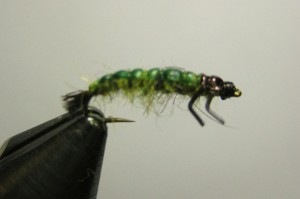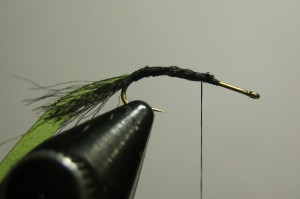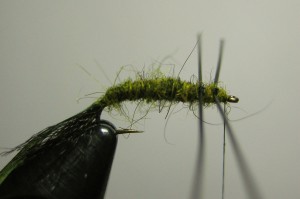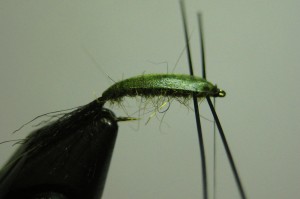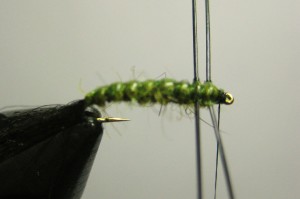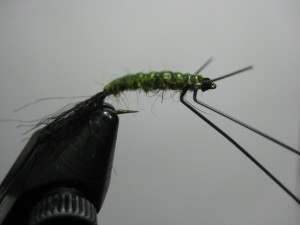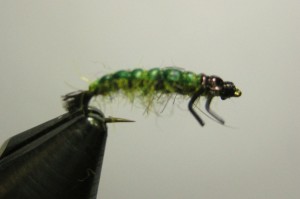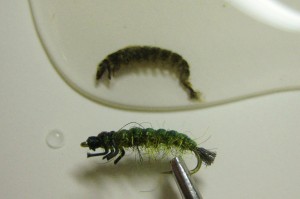Beachy’s Better Caddis (BBC)
Hydropsyche; Non-Cased Caddis Larvae
By Mike Beachy
B B Caddis
Hook 200R TMC size 16
Thread Black 8/0
Tail Black Z-Lon
Ribbing Super Hair Olive or thin mono
Dubbing Spectrablend Dark Olive
Back 1/8” Scud Back Olive
Legs Black Plastic Bristle from work bench dust brush
Coloring Black and Green Sharpie Markers
Step 1) Start the thread base 1/4 shank length back from hook eye leaving the front part of the shank bare. Tie in black Z-lon tail fibers and a single strand of super hair ribbing material and let hang off the back. Trim scud back material into a long taper and tie in toward the back over the bend of the hook. You want to tie the fly down and around the curve of the hook to give the finished fly a curved look. The tail section will be smaller diameter then the front so you only want the scud back to wrap about half way around the body when you are done with no scud back covering the belly portion.
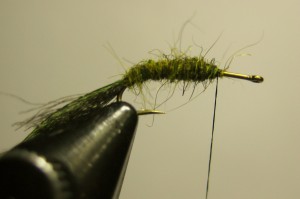 <
Step 2) Dub the body of the bug building a taper towards the 1/4 point where you started your thread. Try and keep the tail tip portion as skinny as possible.
<
Step 2) Dub the body of the bug building a taper towards the 1/4 point where you started your thread. Try and keep the tail tip portion as skinny as possible.
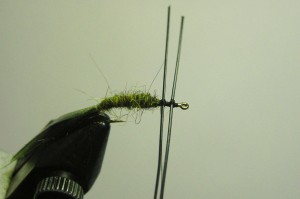
Step 3) Tie in two sets of legs using two plastic bristles cut from a work bench dust brush. I purchased a dust brush from Menards for a couple bucks with enough bristles to last me 10 lifetimes. Chances are good that you have something similar in your garage that will work. The plastic fibers work well since they can be bent and they maintain the shape with very little memory spring back. Tie the first at the 1/4 point then the second, half way between the first and the hook eye. Leave the legs long and straight for ease in tying the rest of the fly. The legs should look like two airplane wings sticking out from the hook shank, perpendicular to the shank and parallel to each other.
Step 4) Dub the remaining shank in a descending cone toward the hook eye around and between the legs using the same dubbing as prior.
Step 5) Pull stretch scud back material forward over the back of the bug and tie it off behind the hook eye. Take the super hair fiber (or small mono line) and spiral wrap 8 to 10 segments over the scud back. Pull firmly downward across the scud back to make indentations without rotating the scud back off the back of the fly. Segment the entire length forward between the legs and tie off behind the hook eye.
Step 6) Tie a small black head with thread. Finish, trim thread and glue head of fly.
Step 7) Bend the plastic legs straight down on each side of the body towards the belly. Using a forceps or tweezers bend the legs forwards to create an elbow. The legs should end up pointing towards the hook eye and slightly outwards. Cut excess leg material off.
Step 8) Trim the Z-lon tail into a short little brush. Use a black permanent marker to blacken the first two or three back segments of scud back material behind the head. Do not go beyond the legs. You can darken the remaining scud back with a little green or brown marker if you so desire. Pick out the dubbing material in the belly of the abdomen to represent the gills. Leave gills short by trimming longer dubbing hairs.
Finished fly looks very lifelike. In the photo you can see the fly next to a real free swimming caddis. These caddis spin a web to catch floating food and many times get dislodged from their perch and dangle in the current by their web much the same as this fly dangling from your tippet.

